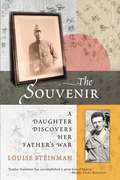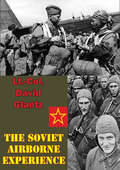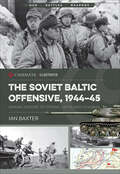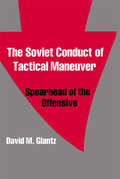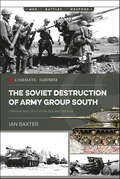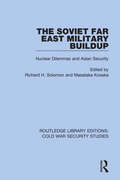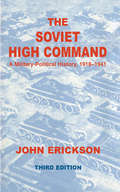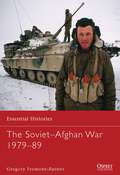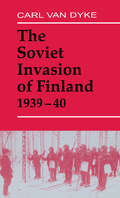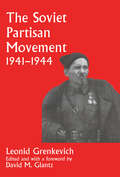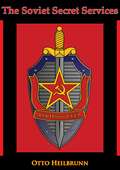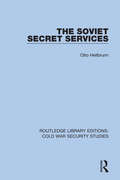- Table View
- List View
The Southern Plantation Overseer as Revealed in his Letters
by John Spencer Bassett James Knox PolkStudy of ante-bellum Southern cotton plantations examined through letters found in the correspondence of U.S. President James Knox Polk. The letters discuss agricultural and economic aspects of the overseerships of several individual planters. Includes an overview of the work, duties, and contractual obligations of the overseer and a chapter on the plantation experience of President Polk.
The Southern Plantation: A Study in the Development and the Accuracy of a Tradition
by Francis Pendleton Gaines"The Southern Plantation: A Study in the Development and the Accuracy of a Tradition" by Francis Pendleton Gaines is a scholarly exploration of the southern plantation system, examining its evolution, cultural significance, and the myths that have shaped its historical legacy. Originally published in 1924, this book provides a nuanced analysis of one of the most iconic and controversial institutions in American history.Francis Pendleton Gaines, a distinguished historian and academic, delves deeply into the origins and development of the plantation system in the Southern United States. Gaines' study is characterized by a critical examination of the romanticized image of the plantation that has permeated American culture. He scrutinizes the accuracy of popular traditions and narratives, contrasting them with historical records and evidence. Through this approach, Gaines seeks to separate fact from fiction, offering a more accurate and comprehensive understanding of plantation life.The book covers various aspects of plantation society, including the daily lives of planters, the roles and experiences of enslaved people, and the complex relationships that defined the plantation community. Gaines provides insights into the economic operations of plantations, including agricultural practices, labor management, and market dynamics. He also addresses the cultural and social dimensions, such as family structures, social hierarchies, and the influence of plantation life on Southern identity."The Southern Plantation: A Study in the Development and the Accuracy of a Tradition" is an essential resource for historians, students, and anyone interested in the history of the American South. Through this book, readers gain valuable insights into the realities of plantation life and the enduring myths that continue to influence our understanding of the past.
The Souvenir: A Daughter Discovers Her Father's War
by Louise SteinmanLouise Steinman's father never talked about his experiences in the Pacific during WWII, like many men of his generation. All she knew was that a whistling kettle unnerved him, that Asian food was banned from the house, and that she was never to cry in front of him. After her parents' deaths, Steinman discovered a box containing some four hundred letters her father had written to her mother during the war. Among the letters, she found a Japanese flag inscribed with elegant calligraphy. The flag said: "To Yoshio Shimizu given to him in the Great East Asian War to be fought to the end. If you believe in it, you win." Intrigued by her father's letters and compelled to know how this flag came to be in his possession, Steinman sets out on a quest to learn what happened to her father and the men of his Twenty-fifth Infantry Division. Over the course of her exploration, Steinman decides to return the flag to the family of Yoshio Shimizu, the fallen Japanese soldier. She travels to the snow country of Japan and visits the battlefield in the Philippines where her father's division fought-the place where Yoshio lost his life and his flag. In the end, Steinman discovers a side of her father she never knew, and, astonishingly, she develops a kinship with the surviving family of his enemy. Weaving together her father's letters with the story of her own personal journey, Steinman presents a powerful view of how war changed one generation and shaped another.
The Souvenir: A Daughter Discovers Her Father's War
by Louise SteinmanLouise Steinman's American childhood in the fifties was bound by one unequivocal condition: "Never mention the war to your father." That silence sustained itself until the fateful day Steinman opened an old ammunition box left behind after her parents' death. In it she discovered nearly 500 letters her father had written to her mother during his service in the Pacific War and a Japanese flag mysteriously inscribed to Yoshio Shimizu. Setting out to determine the identity of Yoshio Shimizu and the origins of the silken flag, Steinman discovered the unexpected: a hidden side of her father, the green soldier who achingly left his pregnant wife to fight for his life in a brutal 165-day campaign that changed him forever. Her journey to return the "souvenir" to its owner not only takes Steinman on a passage to Japan and the Philippines, but also returns her to the age of her father's innocence, where she learned of the tender and expressive man she'd never known. Steinman writes with the same poignant immediacy her father did in his letters. Together their stories in The Souvenir create an evocative testament to the ways in which war changes one generation and shapes another.
The Sovereign (Magic of the Lost #3)
by C. L. ClarkThe Sovereign brings princess Luca and soldier Touraine together one last time in the thrilling conclusion to C. L. Clark's beloved queer political fantasy trilogy. Luca is the new queen of Balladaire. Her empire is already splintering in her hands. Her uncle wasn&’t the only traitor in the court, and the Withering plague will decimate her people if she can&’t unearth Balladaire&’s magic. The only person who can help her wants the only thing Luca won&’t give—the end of the monarchy. Touraine is Luca&’s general. She has everything she ever wanted. While Luca looks within Balladaire&’s borders, Touraine looks outward—the alliance with Qazal is brittle and Balladaire&’s neighbors are ready to pounce on its new weakness. When the army comes, led by none other than Touraine&’s old lover, Touraine must face the truth about herself—and the empire she once called home. A storm is coming. Touraine and Luca will stand against it together, or it will tear them apart once and for all.Magic of the LostThe Unbroken The Faithless The Sovereign
The Sovereign: Magic of the Lost, Book 3 (Magic of the Lost #3)
by C. L. ClarkThe Sovereign brings princess Luca and soldier Touraine together one last time in the thrilling conclusion to C. L. Clark's beloved queer political fantasy trilogy. Luca is the new queen of Balladaire. Her empire is already splintering in her hands. Her uncle wasn't the only traitor in the court, and the Withering plague will decimate her people if she can't unearth Balladaire's magic. The only person who can help her wants the only thing Luca won't give-the end of the monarchy. Touraine is Luca's general. She has everything she ever wanted. While Luca looks within Balladaire's borders, Touraine looks outward-the alliance with Qazal is brittle and Balladaire's neighbors are ready to pounce on its new weakness. When the army comes, led by none other than Touraine's old lover, Touraine must face the truth about herself-and the empire she once called home. A storm is coming. Touraine and Luca will stand against it together, or it will tear them apart once and for all.Magic of the Lost:The UnbrokenThe FaithlessThe Sovereign
The Soviet Air Force And Strategic Bombing
by Major Philip A. StempleIt is the purpose of this project to show why the Soviet Air Force did not embrace the revolutionary Douhetian concept of strategic bombing as did other world powers during the 1920's, 30's and World War II. It is also to explain that in addition to technological shortcomings, there was a combination of theoretical and doctrinal reasons, taken to rigidity, that was responsible for this. Moreover, to show that when the revolution in military affairs (RMA) of nuclear weapons occurred strategic bombing was adopted. Additionally, that even as strategic bombing became fundamental to Soviet strategic doctrine during the Cold War, it was not at the exclusion of a more traditional Red Air Force role.
The Soviet Airborne Experience [Illustrated Edition]
by Colonel David M Glantz[Includes 36 maps and 10 tables]Deep battle, a major element in both U.S. and Soviet doctrine, is a tenet that emphasizes destroying, suppressing, or disorganizing enemy forces not only at the line of contact, but throughout the depth of the battlefield. Airborne forces are a primary instrument to accomplish this type of operation. While the exploits of German, British, and American paratroops since 1940 are well known to most professional soldiers, the equivalent experience of the Soviet Union has been largely ignored--except in the Soviet Union. There, the Red Army's airborne operations have become the focus of many recent studies by military theorists.Lieutenant Colonel David M. Glantz has done much to remedy this gap in our historical literature. The Soviet Airborne Experience examines the experiences of the Red Army in World War II and traces Soviet airborne theory and practice both before and since the Great Patriotic War of 1941-45. Airborne warfare emerges as an essential part of the high-speed offensive operations planned by Soviet commanders.Because Lieutenant Colonel Glantz examines airborne operations within the larger context of Soviet unconventional warfare, the implications of this study reach beyond one specialized form of maneuver. This study, in demonstrating the ability of Russian airborne and partisan forces to survive and fight behind German lines for months at a time, provides us with an instructive example of how Soviet special operations troops probably plan to operate in future wars. The Soviet Airborne Experience is an important reference for anyone concerned with planning and conducting operations.
The Soviet Baltic Offensive, 1944–45: German Defense of Estonia, Latvia, and Lithuania (Casemate Illustrated #Cis0024)
by Ian BaxterA fully illustrated account of the Soviet offensive in the Baltics and the desperate German attempts to hold back the Red Army.This is a compelling account of the German defense of the Baltic States of Estonia, Latvia and Lithuania. Against overwhelming Soviet forces the book shows how the German Army Group North was driven across the Baltics from Leningrad and fought a number isolated battles including the defense of Narva, Memel and the Kurland pocket. The book outlines in dramatic detail how Hitler forbade his troops to withdraw, ordering them to follow his Halt Order Decree and fight to the death. However, exhausted and demoralized by continuous Soviet assaults, Army Group North became cut-off and isolated, fighting fanatically to hold the capital cities of Tallin, Vilnius and Riga. What followed were German forces fighting to the death in the last few small pockets of land surrounding three ports: Libau in Kurland, Pillau in East Prussia and Danzig at the mouth of the River Vistula. In the Kurland, German divisions became surrounded and fought a vicious defense until May 1945. Drawing on a host of rare and unpublished photographs accompanied by in-depth captions and text, the book provides an absorbing read of the Red Army’s conquering of the Baltics.
The Soviet Biological Weapons Program
by Milton Leitenberg Raymond A. Zilinskas Jens H. KuhnRussian officials claim today that the UR never possessed an offensive biological weapons program. In fact, the Soviet government spent billions of rubles and hard currency to fund a hugely expensive weapons program that added nothing to the country’s security. This history is the first attempt to understand the broad scope of the UR’s offensive biological weapons research-its inception in the 1920s, its growth between 1970 and 1990, and its possible remnants in present-day Russia. We learn that the U. S. and U. K. governments never obtained clear evidence of the program’s closure from 1990 to the present day, raising the critical question whether the means for waging biological warfare could be resurrected in Russia in the future. Based on interviews with important Soviet scientists and managers, papers from the Soviet Central Committee, and U. S. and U. K. declassified documents, this book peels back layers of lies, to reveal how and why Soviet leaders decided to develop biological weapons, the scientific resources they dedicated to this task, and the multitude of research institutes that applied themselves to its fulfillment. We learn that Biopreparat, an ostensibly civilian organization, was established to manage a top secret program, code-named Ferment, whose objective was to apply genetic engineering to develop strains of pathogenic agents that had never existed in nature. Leitenberg and Zilinskas consider the performance of the U. S. intelligence community in discovering and assessing these activities, and they examine in detail the crucial years 1985 to 1992, when Mikhail Gorbachev’s attempts to put an end to the program were thwarted as they were under Yeltsin.
The Soviet Biological Weapons Program: A History
by Milton Leitenberg Raymond A Zilinskas Jens H KuhnThis is the first attempt to understand the full scope of the USSR’s offensive biological weapons research, from inception in the 1920s. Gorbachev tried to end the program, but the U.S. and U.K. never obtained clear evidence that he succeeded, raising the question whether the means for waging biological warfare could be present in Russia today.
The Soviet Conduct of Tactical Maneuver: Spearhead of the Offensive (Soviet (Russian) Military Theory and Practice)
by David GlantzFirst Published in 1991. Routledge is an imprint of Taylor & Francis, an informa company.
The Soviet Destruction of Army Group South: Ukraine and Southern Poland 1943–1945 (Casemate Illustrated #Cis0029)
by Ian BaxterA fully illustrated account of how the Third Reich’s Army Group South was defeated in 1944–forty-five by the Soviet Red Army.Following the destruction of Sixth Army at Stalingrad in February 1943, Army Group South slowly withdrew westwards, using the Dnieper as a fortified position. In late 1943, the Soviet 1st, 2nd, 3rd, and 4th Ukrainian Front launched a strategic offensive against the German Army Group South A—one of the largest operations of the war. In May 1944, Red Army troops defeated Army Group South and Army Group A on the Dnieper. Many thousands of German troops evacuated across the Black Sea. In July, troops of the 1st Ukrainian Front launched an operation into the Crimea. The offensive coincided with other Red Army operations further north, including the Lublin-Brest Offensive—part of Operation Bagration. Slowly and inexorably, the powerful Russian attacks forced the tattered German army group to retreat hundreds of miles west, into Eastern Poland and Romania. Here German forces defended their positions and built defenses in Hungary and Austria to try to slow down the overwhelming might of the Red Army. There, the Germans would fight a series of desperate battles until the remnants surrendered in early May 1945.Drawing on rare and previously unpublished images accompanied by detailed captions and text, the book gives a fascinating analysis of the destruction of Army Group South in southern Russia between 1944 and 1945.
The Soviet Far East Military Buildup: Nuclear Dilemmas and Asian Security (Routledge Library Editions: Cold War Security Studies #48)
by Richard H. Solomon; Masataka KosakaThis book, first published in 1986, examines the challenges the United States faced in maintaining a strong nuclear deterrence capability in the Far East without giving rise to political tensions among its allies. The Soviet aggression in the region, shown in the invasion of Afghanistan and the shooting down of a Korean airliner, demonstrated the need for a Western counterbalance, but the Asian nations were wary of becoming pawns in a nuclear power play between the superpowers. This book evaluates the meaning of Moscow’s military buildup in the global context; analyses the impact of the buildup from the perspective of China, Korea, Japan, the nations of ASEAN, Australia and New Zealand; explores the interaction of the buildup with the unresolved conflict on the Korean peninsula; and assesses the European experience with the Soviet nuclear threat and examines its implications for Asia. It also evaluates the linkages between European and Asian security.
The Soviet High Command: A Military Political History, 1918-1941
by John EricksonAn objective and documentary history of the earliest origins and formative years of the Workers-Peasants Red Army from the Civil War to the initial disasters of the war with Germany, the Great Patriotic War, culminating in the "battle for Moscow" in November-December 1941.
The Soviet Infantryman on the Eastern Front
by Simon FortyA fully illustrated survey of the Soviet infantryman on the Eastern Front in World War II. The Soviet Army was ill-prepared for its ally’s treacherous onslaught in 1941. Its officer corps decimated by Stalin’s purges and its men less well-trained than the Germans, the Red Army was poorly led, hampered by the power of the political officers and only partly mobilized. But, in spite of the huge German victories and the speed of the Nazi attack, the Soviets proved fantastically capable of rolling with the punches. The vast territory of the Soviet Union and huge population were significant, as was substantial assistance from the West—the United States and Britain in particular—which was in evidence when the German columns got to within a few miles short of Moscow and were held and then forced back. The tide turned thanks to help from outside and the efforts of the Soviet soldiers, who proved hardy and durable. And just like its soldiers, Russian infantry equipment was rugged and effective. While Soviet infantrymen may not have had the flexibility or tactical nous of the Germans, they did not lack cunning: deception, camouflage skills and endurance made Russian snipers, as an example, more than the equal of the Germans. Most of the views of the Soviet soldier and campaign are influenced by self-serving German postwar accounts designed to excuse their loss by suggesting that Adolf Hitler’s meddling and Soviet numbers were the main reasons for victory: this denigrates the Russian infantryman whose toughness and ingenuity helped destroy the Third Reich in spite of the faults of its own regime. Fully illustrated with over 150 contemporary photographs and illustrations, Soviet Infantryman on the Eastern Front in the Casemate Illustrated series provides an insight into the Soviets’ main theater of operations in World War II.
The Soviet Invasion of Afghanistan 1979-89
by Gregory BarnesThe Soviet invasion of neighbouring Afghanistan in December 1979 sparked a bloody nine-year conflict with the Mujahideen until Soviet forces withdrew in 1988-89, dooming the communist Afghanistan government to defeat by Afghan popular resistance backed by the USA and other powers. The Soviet invasion had enormous implications on the global stage; it prompted the US Senate to refuse to ratify the hard-won SALT II arms-limitation treaty, and the USA and 64 other countries boycotted the 1980 Moscow Summer Olympics. For Afghanistan, the invasion served to prolong the interminable civil war that pitted central government against the regions and faction against faction. The country remains locked in conflict over 30 years later, with no end in sight.For over a year before the invasion the communist Afghan government, installed following a coup and intent on forcibly modernizing the country's civil law in the face of centuries of feudal practices, had called for Soviet armed assistance in its efforts to overcome the open rebellion of the Mujahideen. Fearing the international consequences should the Afghan government be toppled, the Soviets decided to invade. From the outset, though, they failed to understand that communist principles were incompatible with traditional tribal relationships - especially in a country notorious for its poor communications and resistance to centralization.The Soviets found that their forces, largely made up of conscripts untrained in mountain warfare and counter-insurgency - and deploying 'conventional' weapons such as tanks and helicopters - could not defeat guerrillas enjoying the support of both the local population and powerful foreign allies such as the USA, and operating in harsh mountainous and/or desert terrain that favoured the defenders. The Soviets decided to stage a phased withdrawal of their own forces and concentrated on building up the Afghan government forces, but the Mujahideen soon prevailed, ushering in a new era dominated by the Taliban, an Islamist militia group that controlled large parts of the country from the mid-1990s.Featuring specially drawn mapping and drawing upon a wide range of sources, this succinct account explains the origins, history and consequences of the Soviet intervention in Afghanistan, thereby shedding new light on the more recent history - and prospects - of that troubled country.From the Trade Paperback edition.
The Soviet Invasion of Finland, 1939-40 (Soviet (Russian) Military Experience #No. 3)
by Carl Van DykeWestern accounts of the Soviet-Finnish war have been reliant on Western sources. Using Russian archival and previously classified secondary sources to document the experience of the Red Army in conflict with Finland, Carl Van Dyke offers a reassessment of the conflict.
The Soviet Partisan Movement, 1941-1944 (World War Ii Monographs #Vol. 211)
by Edgar M. HowellThe purpose of this text is to provide the Army with a factual account of the organization and operations of the Soviet resistance movement behind the German forces on the Eastern Front during World War II. This movement offers a particularly valuable case study, for it can be viewed both in relation to the German occupation in the Soviet Union and to the offensive and defensive operations of the Wehrmacht and the Red Army.The scope of the study includes an over-all picture of a quasi-military organization in relation to a larger conflict between two regular armies. It is not a study in partisan tactics, nor is it intended to be. German measures taken to combat the partisan movement are sketched in, but the story in large part remains that of an organization and how it operated. The German planning for the invasion of Russia is treated at some length because many of the circumstances which favored the rise and development of the movement had their bases in errors the Germans made in their initial planning. The operations of the Wehrmacht and the Red Army are likewise described in considerable detail as the backdrop against which the operations of the partisan units are projected.Because of the lack of reliable Soviet sources, the story has been told much as the Germans recorded it. German documents written during the course of World War II constitute the principal sources, but many survivors who had experience in Russia have made important contributions based upon their personal experience.
The Soviet Partisan Movement, 1941-1944: A Critical Historiographical Analysis (Soviet (Russian) Military Experience #No. 4)
by Leonid D. GrenkevichPartisans and terrorists have dominated military history during the second half of the 20th century. Leonid Grenkevich offers an account of the shadowy partisan struggle that accompanied the Soviet Union's Great Patriotic War (1941-1945).
The Soviet Secret Services
by Dr Otto HeilbrunnEspionage, subversion, infiltration, and sabotage are shown by an analysis of Soviet case material to be Soviet instruments of war. The author considers Soviet intelligence work in Germany in WWII to be a classic in espionage. He sees psychological warfare in all its aspects as a new usage of war. His fundamental position is that we must assess the Russian clandestine war potential, must be able to deal with it, and must ourselves be able to wage a war without battlefield.
The Soviet Secret Services (Routledge Library Editions: Cold War Security Studies #53)
by Otto HeilbrunnThis book, first published in 1956, analyses the Red Army’s strategic planning for a war involving nuclear weapons – whereby the front line is thinned out to protect it from nuclear attack and replaced by large-scale offensive operations in NATO’s rear. This new warfare technique had been successfully practised in WWII by Soviet partisan and guerrilla forces, and this book examines these foundations of Soviet secret services doctrine, and the principles by which they would operate.
The Soviet Sisters: A Novel of the Cold War
by Anika ScottFrom bestselling author of The German Heiress, a gripping new historical novel filled with secrets, lies, and betrayals, following two spy sisters during the Cold War."Anika Scott pens a fascinating tale of secrets, surveillance, and sisterhood.... The Soviet Sisters will suck you in to the very last page!" —Kate Quinn, New York Times bestselling author of The Diamond Eye“Electrifying, meticulously researched, and expertly plotted, The Soviet Sisters is at once a Cold War thriller, a gripping spy story, a page-turning mystery, and a familial drama.” —Lara Prescott, New York Times bestselling authorSisters Vera and Marya were brought up as good Soviets: obedient despite hardships of poverty and tragedy, committed to communist ideals, and loyal to Stalin. Several years after fighting on the Eastern front, both women find themselves deep in the mire of conflicts shaping a new world order in 1947 Berlin. When Marya, an interpreter, gets entangled in Vera’s cryptic web of deceit and betrayal, she must make desperate choices to survive—and protect those she loves.Nine years later, Marya is a prisoner in a Siberian work camp when Vera, a doyenne of the KGB, has cause to reopen her case file and investigate the facts behind her sister's conviction all those years ago in Berlin. As Vera retraces the steps that brought them both to that pivotal moment in 1947, she unravels unexpected truths and discoveries that call into question the very history the Soviets were working hard to cover up.Epic and intimate, layered and complex, The Soviet Sisters is a gripping story of spies, blackmail, and double, triple bluff. With her dexterous plotting and talent for teasing out moral ambiguity, Anika Scott expertly portrays a story about love, conflicting world views, and loyalty and betrayal between sisters.
The Soviet Strategic Offensive in Manchuria, 1945: 'August Storm' (Cass Series On Soviet (russian) Military Experience #Vol. 7)
by David GlantzThis critical examination of the final Soviet strategic offensive operation during World War II seeks to chip away at two generally inaccurate pictures many Westerners have of the war. Specifically, Westerners seem to think that only geography, climate, and sheer numbers negated German military skill and competency on the eastern front, a view that
The Soviet Union and Northern Waters (Routledge Library Editions: Cold War Security Studies #56)
by Clive ArcherThis book, first published in 1988, analyses the interests and activities of the Soviet Union in the northern Atlantic. It gives particular attention to the growth in exploration and exploitation of resources and to the problems presented by jurisdictional disputes. The responses of NATO, the United States and the Nordic countries to the expanded Soviet military presence are examined in detail.



